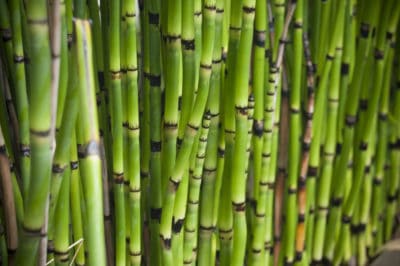Why Grow Bamboo-Like Plants?
Although the bamboo family contains many different species, it has some limitations and some varieties can be invasive. You might want to grow bamboo-like plants for the following reasons:
- Some make better houseplants.
- Some can tolerate standing water and marshy conditions.
- Some produce colorful fruit or berries.
- They may be easier to control than bamboo.
Lucky Bamboo
This houseplant is also known as ribbon plant, million bamboos and Belgian evergreen. Its official name is Dracaena sanderiana, and it is related to the houseplant commonly called corn plant. A member of the lily family, it also grows outdoors in USDA Zones 10 and 11. It will grow in soil or plain water and prefers bright indirect light.
Horsetail
Equisetum hyemale is an ancient plant closely related to ferns. In addition to horsetail, it is often known as snake grass and puzzle grass, although it is not a member of the grass family. Native to North America, these plants grow two to six feet tall in USDA Zones 4 to 9. They are aggressive growers and can handle varying light conditions as well as standing water.
Giant Reed
Called “giant” for good reason, this perennial is native to the Mediterranean basin. It resembles both corn plants and bamboo and can grow to a height of 20 feet. Common names for Arundo donax include Carrizo, Colorado river reed, Spanish cane and wild cane. A member of the grass family, it can be invasive and when dry is highly flammable. It does regrow readily after a fire.
Heavenly Bamboo
Also known as sacred bamboo, Nandina domestica is a member of the barberry family. It contains high concentrations of hydrocyanic acid and is poisonous to humans and animals. Native to eastern Asia, it is considered invasive in several states because the seeds are easily spread by wild birds. It also spreads by underground rhizomes. It is evergreen and hardy from USDA Zones 5 to 10.
Bamboo Palm
Of all the plants noted here, Chamaedorea seifritzii, or bamboo palm, looks the most like true bamboo. Native to Central and South America, it grows about seven feet tall in USDA Zones 10 to 12. It is also used as a houseplant. Bamboo palm produces interesting inedible clusters of purple-black fruits that can irritate the skin.
